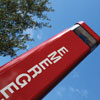
A Trail of Blue Lights
Student, visitor safety is paramount at FSU
- By Bob Shanes
- Nov 01, 2011
Florida State University has a rich history of
providing quality education to a diverse population.
With its impress ive breadth of graduate,
profess ional and undergraduate programs,
FSU is demanding and intellectually
stimulating, yet it provides a warm and caring
environment for students and faculty.
Student and guest safety is paramount on FSU campuses so the university
can create an inviting environment and continue to attract top
talent. One of the university’s major public safety initiatives is the Blue
Light Trail, which now constitutes more than 400 strategically placed
blue light towers equipped with emergency phones and blue lights.
The towers are designed to give passersby a sense of security by
providing a reliable two-way communication link with university
police at the push of a button. The technology is not new, but it has
nevertheless proven invaluable on more than one occasion. The number
of towers continues to grow as the campus’s safety needs grow.
FSU has had a variety of blue light emergency phones from other
manufacturers installed on some of its campuses, but this time it
turned to Talk-A-Phone to provide the installations. Having multiple
vendors on the site allowed FSU to test the blue light emergency
phones thoroughly before settling on one vendor. Talk-A-Phone not
only satisfied the university’s technical requirements and reliability
tests, but it also proved that aesthetics should not come at extra cost.
Universities implementing the towers have the choice of a wide
variety of color and lettering styles. FSU chose its theme color, Chilean
Red, and opted for gold lettering on all four sides to reflect the
university’s identity. The emergency phones were also customized to
fit the needs of the university’s campuses.
“When we wanted a phone that would work with current vendors’
towers, they provided it and promised continued support for the
phones no matter how old they are,” said Larry Downing, a network
specialist at the university. “When we needed a delay timer in the unit
so we could do some special alert messaging interface with the Red
Alert, they designed one.”
Another distinctive feature of Talk-A-Phone’s emergency phones is
their ability to fit into a majority of existing mounting accessories from
other manufacturers, making an upgrade as easy as a simple swap of
the phone.
Blue Light Safety, Even in a Thunderstorm
Thunderstorms and lightning are a grave concern for the FSU community.
Located in Tallahassee, Fla., the university’s 15 colleges are in
the heart of a thunderstorm-riddled region, leading the nation in an
average lightning density per square foot. Needless to say, having a
reliable emergency communication link is significant from both a legal
and public relations perspective.
In the interest of safety for all facility staff, students and visitors,
FSU developed a comprehensive emergency phone program. As part
of this program, a full-time employee tests and repairs the blue light
emergency phones in case of lightning outages.
“It is the belief of the emergency phone technician that the Talk-APhone
units are more robust, particularly in the realm of surviving
lightning strikes,” said Colleen Thomas of FSU’s telecommunications
office. “While all phones are fitted with the same external surge protection,
the units we have now are more often spared or at least are repairable
when a surge is sufficient to get through the protection device.”
Although the university endeavored to protect the emergency
phones with heavy-duty surge suppressors, severe lightning was still a
major concern. Talk-A-Phone’s ability to stand up to storm conditions
played an important role in FSU’s selection of emergency phones moving
forward.
“With lightning being so prevalent in this area and having been a
major factor in phone replacements in the past, we have experienced
cost savings in this regard as well,” Thomas said.
Ingenuity, Luminous Efficacy and Safety
Satisfying unique environmental demands in various corners of the world
is something that needs to be taken into account when installing outdoor
security apparatuses. Possible lightning strikes are just part of that.
“When you have roughly 30,000 amps (and) 100 million volts making
a direct contact with electronics, chances it will survive are minimal,”
said Talk-A-Phone Chairman Samuel Shanes. “However, we have
acquired a great deal of experience dealing with lightning and other
environmental issues in our 75-year history of making products in the
United States.”
Continuing the tradition of American ingenuity and manufacturing,
the company introduced a new generation of blue lights. The units
are ultra-bright, all-LED blue lights, featuring an exceptional 209
lumens peak rating and a prismatic pattern to enhance visibility at
greater distances. The units' all-LED construction significantly increases
their lifespan, ensuring they will be around to provide reliable service
for years to come.
The biggest benefit of the new blue light lies in its reduced energy
footprint. While being 15 times brighter than the previous generation,
the new blue light is low-maintenance, safe to recycle and has superior
luminous efficacy. The unit provides 19 times more lumens per watt
when flashing and when in “constant on,” which brings significant savings
to a growing number of energy-conscious college and university
campuses in the United States and abroad.
The university’s decision to standardize its lights will continue to
save scarce monetary resources while providing the priceless benefit of
student and faculty safety. Confidence is at an all-time high at FSU
that the blue light towers and emergency phones will operate effectively
when they are most needed.
This article originally appeared in the November 2011 issue of Security Today.